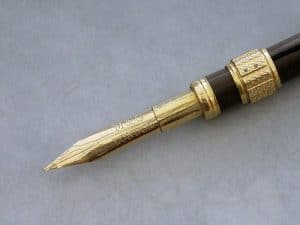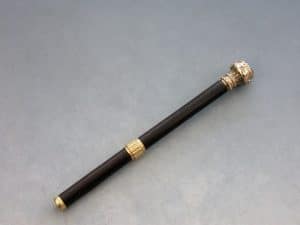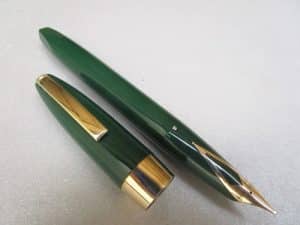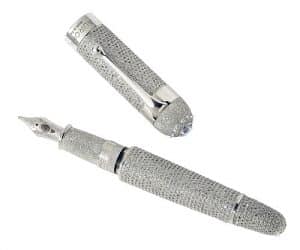The Power of the Pen
by Jessica Kosinski
For as long as humanity has existed, communication has been essential. Today, computers are commonly used to communicate. It is easy to send an email across thousands of miles in a matter of seconds. However, handwritten communication is also still a part of modern culture, and it is one many of us take for granted every day. There was a time when modern writing implements did not exist. People wrote using quills and containers of ink. That is, until an incredible innovation called the fountain pen was developed. Let’s take a peek at the development of fountain pens, their impact on communication, and how to collect them today.
A good quality mid 19th century American gold mounted combination Propelling Pencil and nib holder, the barrel formed from “India Rubber”. The barrel is imprinted “Goodyear’s Pat. May 6 ‘51,” a reference to patent number 8,075 issued to Nelson Goodyear of New York on the 6th May 1851. The chased gold terminal set with a bloodstone seal and unscrewing to reveal a lead reservoir. The pencil is extended by twisting the lower half of the barrel and the pen slides out via the slider ring. (photo: Steppes Hill Farm Antiques Ltd)
Early Writing Processes and the Need for Fountain Pens
People have communicated in many different ways since ancient times. Cave drawings are evidence of that. Eventually, people began using feathers or other implements dipped in ink to write. However, that process was cumbersome and often messy. Each time the quill was dipped, it had the chance of dripping and causing ink splotches on the page. There was also the possibility of an inkwell being tipped over. Such accidents soon led to the need to seek out other options.
Writings from an African caliph from AD 973 indicate the search was on for a more efficient way to write at least that early. Around the globe different cultures kept trying to improve writing techniques over the centuries. One of the most famous and well documented examples came from the mind of the famous inventor, Leonardo da Vinci. Drawings of a fountain pen-like writing implement he made survived. Although no actual pen has survived, it is believed he did build the pen he drew and used it for his own purposes.
The Earliest Fountain Pen Patents
The fountain pen as we know it today is a pen that contains its own reservoir. The reservoir holds ink, eliminating the need for an inkwell. In the 1600s, early pens fitting that description began to pop up quite regularly. However, the earliest registered fountain pen patents known were filed in the 1800s. A Frenchman named Petrache Poenaru filed one of the earliest fountain pen patents in 1827. An insurance broker named Lewis Waterman filed one of the earliest U.S. fountain pen patents in 1884. It is believed he was already using fountain pens designed by other people at the time. However, a pen he was using leaked, leading him to try to develop a better fountain pen design.
Over several decades, primarily starting in the 1850s, fountain pen designs began to change. The earliest fountain pens had several design flaws. For example, leaks were common. Some fountain pens also got clogged, making them impossible to use. Additionally, early fountain pens had no retractable nibs or caps. Therefore, they could easily get ink on anything they came in contact with. The addition of those features made them much more portable and convenient.
By the 1900s, fountain pens had changed in other ways as well. For example, nibs that formerly corroded quickly were replaced by longer-lasting nibs. Advancements in fountain pen reservoirs also made newer fountain pens much easier to refill. New filler types included click, matchstick, coin, lever, and button. Therefore, pens did not have to be replaced as often as they were prior to those design changes.
Popular Fountain Pen Manufacturers
As mentioned earlier, Waterman is a popular maker of fountain pens. One of the most commonly collected Waterman fountain pens is called the Ideal No. 52. It was produced from the 1910s until 1934. It is popular because Waterman continued to produce it with an ebonite barrel, even though other companies began using celluloid barrels around that time.
Pens designed by Walter Sheaffer are also prized by fountain pen collectors. In 1908, he took out a patent for a lever-filled fountain pen. Production began in 1912 in Fort Madison, Iowa. Sheaffer pens were unique in construction and color at the time because they had celluloid barrels. One of the most unique Sheaffer pens was the Sheaffer Balance, which was torpedo-shaped, as opposed to all the cylindrical fountain pens that came before it. Other popular early fountain pen designers included Parker, Wahl-Eversharp and Conklin.
When collecting fountain pens, you must make several decisions, beginning with the types of pens on which you wish to focus. Modern fountain pens are, in many ways, as collectible as antique fountain pens because of the wide variety of shapes, colors and styles available. Early fountain pens are more historically interesting. You must also decide if you intend to use the fountain pens you collect. Used pens or pens purchased from unreliable sources may not work properly or be of the quality you desire.
Your budget must also top your list of concerns when you collect fountain pens. You can find fountain pens almost anywhere for a few dollars. However, the highly collectible models can cost much more, whether they are antique or not. For example, the modern Diamante by Aurora, which is a diamond-encrusted fountain pen, is currently valued at $1.28 million. Only one is produced annually. As far as antique pens are concerned, rarer models are often the most expensive. Among the most difficult to find are some of the Waterman No. 5 and No. 7 “Ripple” pens. They featured color-coded nibs with matching stripes on their caps. White and pink are particularly rare and desirable. A pink-nibbed pen recently sold for five figures. However, the red-nibbed pen from the set is less rare. Therefore, it is more affordably priced at a few hundred dollars.












Related posts: